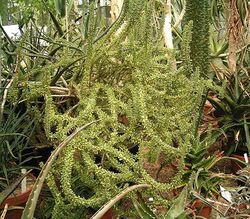Biology:Ceraria
| Ceraria | |
|---|---|

| |
| Ceraria namaquensis | |
| Scientific classification | |
| Kingdom: | |
| (unranked): | |
| (unranked): | |
| (unranked): | |
| Order: | |
| Family: | |
| Subfamily: | |
| Genus: | Ceraria Pearson & Stephens
|
| Species | |
|
Ceraria carrissoana | |
Ceraria is a genus of succulent shrubs, native to South Africa and Namibia.
Taxonomy
Recent phylogenetic tests have shown conclusively that Ceraria is located within the genus Portulacaria, and consequently all species have been accordingly renamed.[1]
Description
They are very slow-growing, semi-deciduous or deciduous, and succulent perennials with a few branches and many small, ovoid leaves along the stems. Branches are pale-barked smooth with papery cortex. These woody-stemmed desert shrubs have many short and ovoid gray-green leaves. Flowers, born on peduncles of 13–17 mm long, with some minute ovate bracts 4 mm long. Calyx with two phyllous, 5 rose-colored, obovate, 2 mm long petals. Five stamens with linear filaments.
Species
- Ceraria carrissoana
- Ceraria evora
- Ceraria fruticulosa
- Ceraria kaokoensis
- Ceraria kuneneana
- Ceraria longipedunculata
- Ceraria namaquensis
- Ceraria pygmaea
- Ceraria schaeferi
References
- ↑ P.Bruyns, M.Oliveira-Neto, G.F. Melo de Pinna, C.Klak: Phylogenetic relationships in the Didiereaceae with special reference to subfamily Portulacarioideae. Taxon 63 (5). October 2014. 1053-1064.
Wikidata ☰ Q1054612 entry

